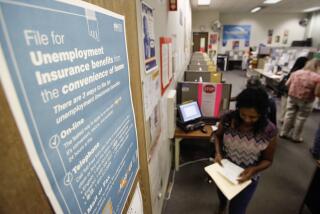Fewer injured stay off payrolls
SACRAMENTO — Moderately injured workers are getting back on the job more quickly since Gov. Arnold Schwarzenegger signed a 2004 overhaul of California’s workers’ compensation insurance system, according to a state study released Wednesday.
But critics called the findings at best inconclusive and at worst an effort to downplay the effects of Schwarzenegger administration regulations that have cut benefits to injured workers as much as 50%.
The report, which dealt with only a small portion of the workers’ comp system, showed that 70% of employees declared permanently but partially disabled from Jan. 1, 2005, to June 30, 2006, returned to work.
That’s a slight improvement from the 65% of the injured population that went back to work in 2003 and 2004, the report said.
However, the administration cautioned that more detailed findings about the law’s effect on injured workers’ incomes won’t be available until 2009.
“This is the first step looking at the limited data to see how the system is working,” said Carrie Nevans, acting director of the California Division of Workers’ Compensation. “This is good news because the goal of the system is to get prompt, effective treatment and get the injured worker back to work.”
Lawmakers ordered the study as part of landmark legislation that halved employers’ once-skyrocketing workers’ comp costs over the last three years.
Since then, advocates for injured workers have been complaining that much of the more than $8 billion in employers’ savings has come at the expense of the permanently disabled.
The partial results in Wednesday’s report and the prospect of waiting for more research to be done did little to quell worker frustration.
“The longer the administration wants to hide behind studies, charts and figures, the longer injured workers suffer,” said Angie Wei, a lobbyist for the California Labor Federation.
Unions will push for passage of a bill this legislative session to boost permanent disability benefits back to higher levels, Wei said. Last year, the governor vetoed a similar proposal by Senate President Pro Tem Don Perata (D-Oakland).
“It’s time to quit studying this to death and act,” Perata said in a statement.
Business groups that pushed for the 2004 overhaul called for more evaluations and said they were heartened by the administration report.
“Better return-to-work rates mean that more injured workers are getting back on the job, where they will experience the least amount of wage loss,” said Allan Zaremberg, president of the California Chamber of Commerce.
But workers’ comp experts cautioned against drawing conclusions from the relatively small number of permanently disabled cases that were reviewed.
The administration looked only at the “milder cases,” and “they can’t extrapolate to the more serious cases,” said Lachlan Taylor, a workers’ comp judge who does research for the state-backed Commission on Health, Safety and Workers’ Compensation.
“This is one part of a bigger picture, and you can’t tell what the picture is until you get more pieces into place,” he said.
*
More to Read
Get the L.A. Times Politics newsletter
Deeply reported insights into legislation, politics and policy from Sacramento, Washington and beyond. In your inbox three times per week.
You may occasionally receive promotional content from the Los Angeles Times.











